June 2011 lunar eclipse
| Total lunar eclipse June 15-16, 2011 | |
|---|---|
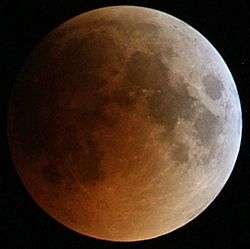 The eclipse as seen from Dar es Salaam, Tanzania | |
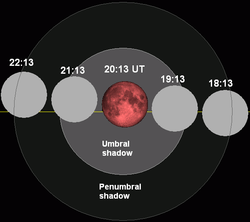 The moon passes right to left through the Earth's shadow | |
| Series (and member) | 130 (34 of 72) |
| Gamma | 0.0897 |
| Duration (hr:mn:sc) | |
| Totality | 01:41:11 |
| Partial | 3:39:58 |
| Penumbral | 5:39:10 |
| Contacts (UTC) | |
| P1 | 17:23:05 |
| U1 | 18:22:37 |
| U2 | 19:22:11 |
| Greatest | 20:12:37 |
| U3 | 21:03:22 |
| U4 | 22:02:35 |
| P4 | 23:02:15 |
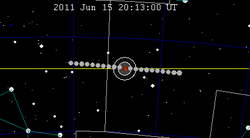 The moon's hourly motion across the Earth's shadow in the constellation of Ophiuchus (north of Scorpius) | |
A total lunar eclipse took place on June 15, 2011. It was the first of two such eclipses in 2011. The second occurred on December 10, 2011.
This was a relatively rare central lunar eclipse, in which the center point of Earth's shadow passes across the moon. The last time a lunar eclipse was closer to the center of the earth's shadow was on July 16, 2000. The next central total lunar eclipse will be on July 27, 2018 over South America, western Africa, and Europe, and setting over eastern Asia.
Visibility and viewing
In western Asia, Australia, and the Philippines, the lunar eclipse was visible just before sunrise.[1] It was very visible in the clear and cloudless night sky throughout eastern and southeast Asia. Africa, far eastern Russia and Europe witnessed the whole event even in the late stages (as in partial lunar eclipse). The Americas (including North and northwestern South America) missed the eclipse completely (except in most areas) because it occurred at moonset.
According to PAGASA, the presence of pollutants over the metropolis which penetrates the reddish appearance of the moon during the greatest stages of the eclipse and sunlight attracts into the atmosphere in the form of red light in contrast to July 1953 and July 2000 lunar eclipses with the same coloration.
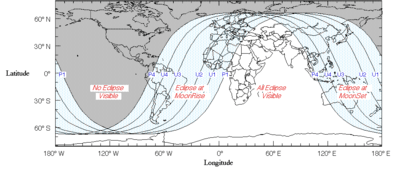 Visibility map |
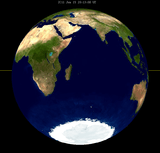 This simulation shows the view of the earth from the moon at greatest eclipse. |
Photo gallery
-
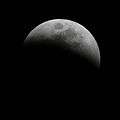
Dar es Salaam, Tanzania, 19:02 UTC
-
.jpg)
Perth, Western Australia, ~21:10 UTC
-
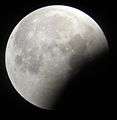
Hungary, 21:50 UTC
| Animation | ||||
|---|---|---|---|---|
|
| Wikimedia Commons has media related to Lunar eclipse of 2011 June 15. |
Related eclipses
It was preceded by the partial solar eclipse of January 4, 2011, and the partial solar eclipse of June 1, 2011.
Semester series
This eclipse is the center of nine lunar eclipses in a short-lived series. Each eclipse in the series repeats after one semester (6 lunations or 177 days) occurring at alternating nodes.
| Lunar eclipse series sets from 2009–2013 | ||||||
|---|---|---|---|---|---|---|
| Ascending node | Descending node | |||||
| Saros # Photo |
Date Viewing |
Type chart |
Saros # Photo |
Date Viewing |
Type chart | |
| 110 | 2009 July 07 |
penumbral |
115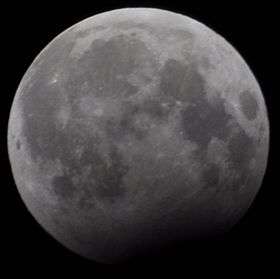 |
2009 Dec 31 |
partial | |
120 |
2010 June 26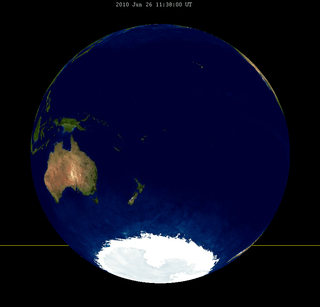 |
partial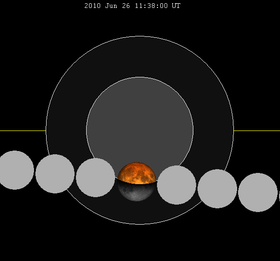 |
125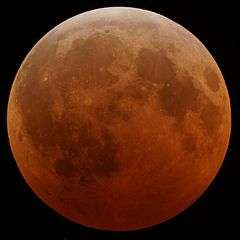 |
2010 Dec 21 |
total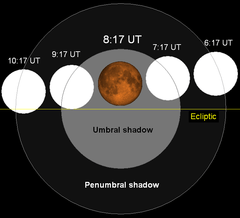 | |
130 |
2011 June 15 |
total |
135 |
2011 Dec 10 |
total | |
140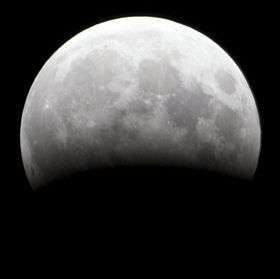 |
2012 June 04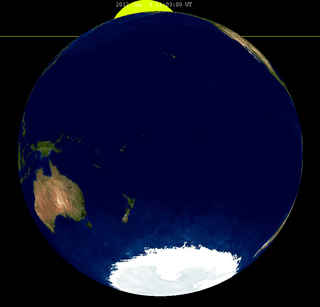 |
partial |
145 | 2012 Nov 28 |
penumbral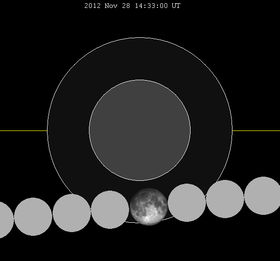 | |
| 150 | 2013 May 25 |
penumbral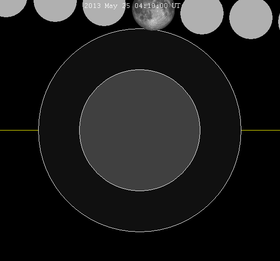 | ||||
| Last set | 2009 Aug 06 | Last set | 2009 Feb 9 | |||
| Next set | 2013 Apr 25 | Next set | 2013 Oct 18 | |||
Saros series
Lunar saros series 130, repeating every 18 years and 11 days, has a total of 72 lunar eclipse events including 14 total lunar eclipses.
| Greatest | First | |||
|---|---|---|---|---|
 The greatest eclipse of the series will occur on 2029 Jun 26, lasting 102 minutes.[2] |
Penumbral | Partial | Total | Central |
| 1416 Jun 10 | 1560 Sep 4 | 1921 Apr 22 | 1957 May 13 | |
| Last | ||||
| Central | Total | Partial | Penumbral | |
| 2083 Jul 29 | 2155 Sep 11 | 2552 May 10 | 2696 Aug 5 | |
| 1903 Apr 12 | 1921 Apr 22 | 1939 May 3 | |||
 |
 |
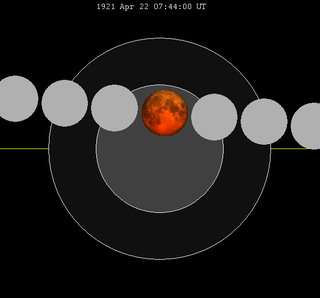 |
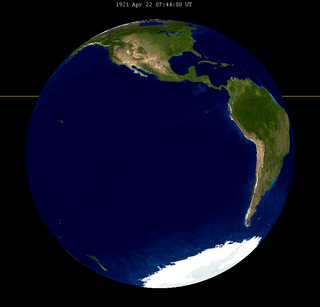 |
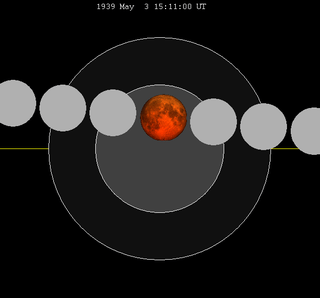 |
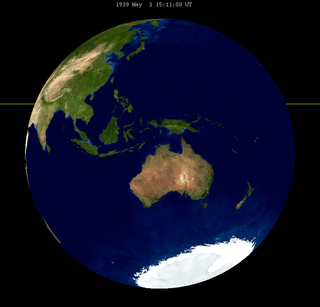 |
| 1957 May 13 | 1975 May 25 | 1993 Jun 4 | |||
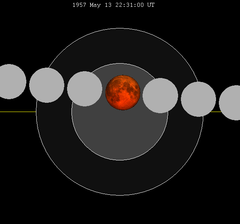 |
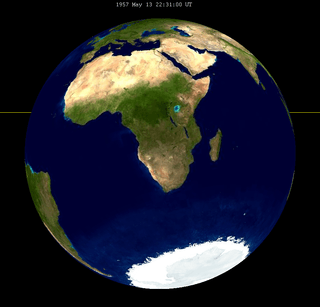 |
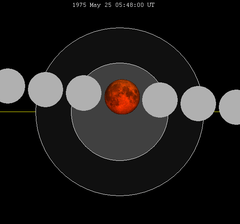 |
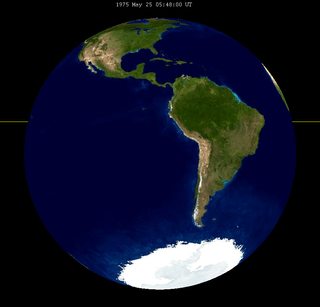 |
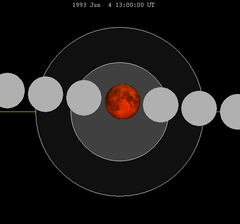 |
 |
| 2011 Jun 15 | 2029 Jun 26 | 2047 Jul 7 | |||
 |
 |
 |
 |
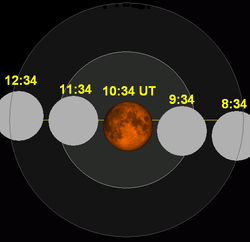 |
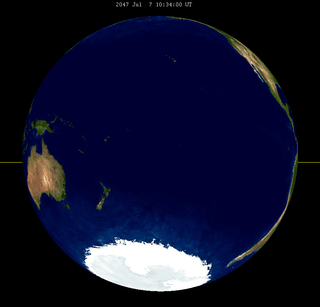 |
| 2065 Jul 17 | 2083 Jul 29 | ||||
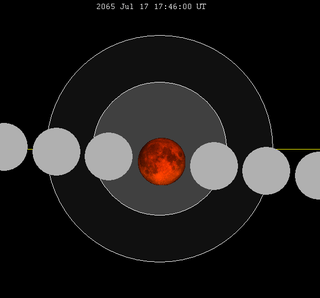 |
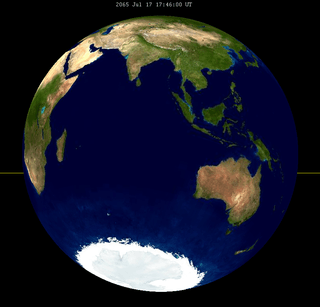 |
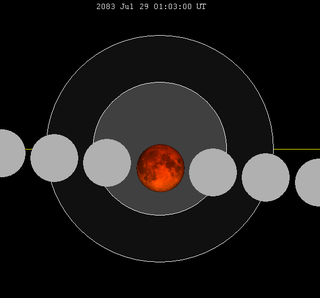 |
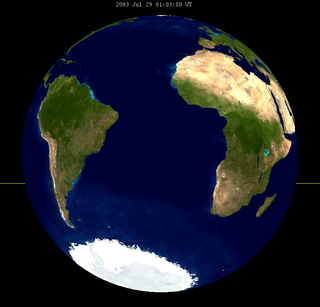 | ||
Tritos series
The tritos series repeats 31 days short of 11 years at alternating nodes. Sequential events have incremental Saros cycle indices.
This series produces 23 total eclipses between June 22, 1880 and August 9, 2120.
| Ascending node | Descending node | |||||
|---|---|---|---|---|---|---|
| Saros | Date Viewing |
Type chart |
Saros | Date Viewing |
Type chart | |
| 119 | 1902 Apr 22 |
Partial |
120 | 1913 Mar 22 |
Partial | |
| 121 | 1924 Feb 20 |
Partial |
122 | 1935 Jan 19 |
Partial | |
| 124 | 1945 Dec 19 |
Partial |
125 | 1956 Nov 18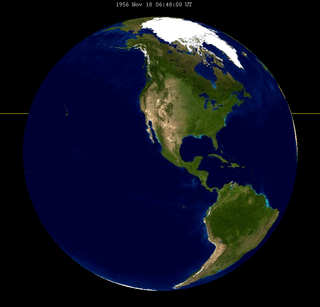 |
Total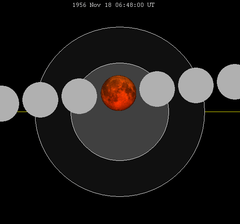 | |
| 126 | 1967 Oct 18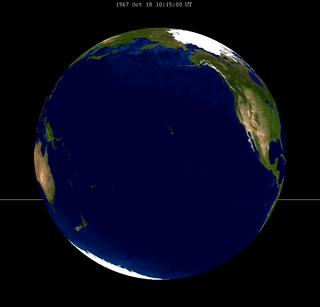 |
Total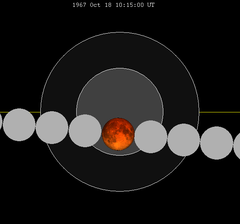 |
127 | 1978 Sep 16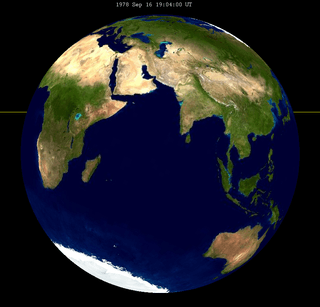 |
Total | |
| 128 | 1989 Aug 17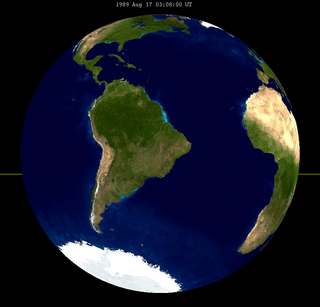 |
Total |
129 | 2000 Jul 16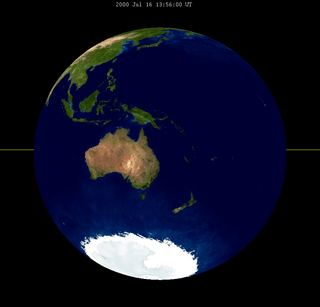 |
Total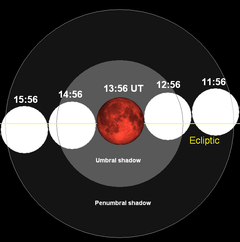 | |
| 130 | 2011 Jun 15 |
Total |
131 | 2022 May 16 |
Total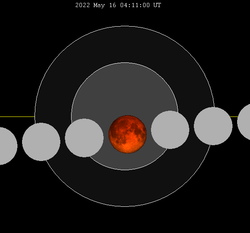 | |
| 132 | 2033 Apr 14 |
Total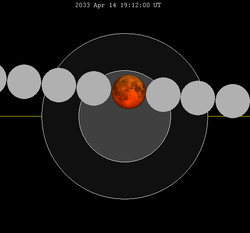 |
133 | 2044 Mar 13 |
Total | |
| 134 | 2055 Feb 11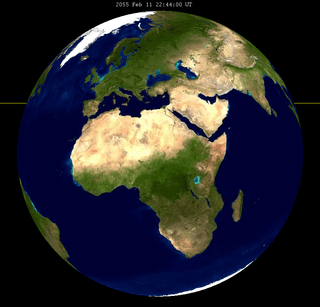 |
Total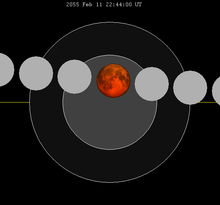 |
135 | 2066 Jan 11 |
Total | |
| 136 | 2076 Dec 10 |
Total |
137 | 2087 Nov 10 |
Total | |
| 138 | 2098 Oct 10 |
Total | ||||
Inex series
The inex series repeats eclipses 20 days short of 29 years, repeating on average every 10571.95 days. This period is equal to 358 lunations (synodic months) and 388.5 draconic months. Saros series increment by one on successive Inex events and repeat at alternate ascending and descending lunar nodes.
This period is 383.6734 anomalistic months (the period of the Moon's elliptical orbital precession). Despite the average 0.05 time-of-day shift between subsequent events, the variation of the Moon in its elliptical orbit at each event causes the actual eclipse time to vary significantly.
All events in this series listed below and more are total lunar eclipses.
| Ascending node | Descending node | Ascending node | Descending node | ||||
|---|---|---|---|---|---|---|---|
| Saros | Date | Saros | Date | Saros | Date | Saros | Date |
| 96 | 1027 Apr 23 | 97 | 1056 Apr 2 | 98 | 1085 Mar 14 | 99 | 1114 Feb 21 |
| 100 | 1143 Feb 1 | 101 | 1172 Jan 13 | 102 | 1200 Dec 22 | 103 | 1229 Dec 2 |
| 104 | 1258 Nov 12 | 105 | 1287 Oct 22 | 106 | 1316 Oct 2 | 107 | 1345 Sep 12 |
| 108 | 1374 Aug 22 | 109 | 1403 Aug 2 | 110 | 1432 Jul 13 | 111 | 1461 Jun 22 |
| 112 | 1490 Jun 2 | 113 | 1519 May 14 | 114 | 1548 Apr 22 | 115 | 1577 Apr 2 |
| 116 | 1606 Mar 24 | 117 | 1635 Mar 3 | 118 | 1664 Feb 11 | 119 | 1693 Jan 22 |
| 120 | 1722 Jan 2 | 121 | 1750 Dec 13 | 122 | 1779 Nov 23 | 123 | 1808 Nov 3 |
| 124 | 1837 Oct 13 | 125 | 1866 Sep 24 | 126 | 1895 Sep 4 | 127 | 1924 Aug 14 |
| 128 | 1953 Jul 26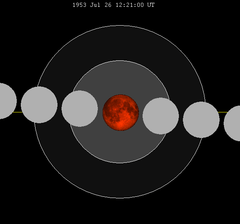 |
129 | 1982 Jul 6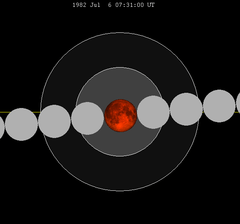 |
130 | 2011 Jun 15 |
131 | 2040 May 26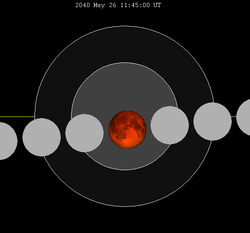 |
| 132 | 2069 May 6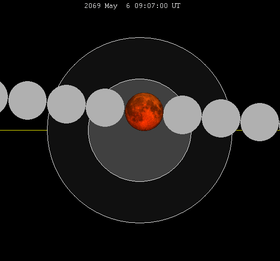 |
133 | 2098 Apr 15 |
134 | 2127 Mar 28 | 135 | 2156 Mar 7 |
| 136 | 2185 Feb 14 | 137 | 2214 Jan 27 | 138 | 2243 Jan 7 | 139 | 2271 Dec 17 |
| 140 | 2300 Nov 27 | 141 | 2329 Nov 7 | 142 | 2358 Oct 18 | 143 | 2387 Sep 28 |
| 144 | 2416 Sep 7 | 145 | 2445 Aug 17 | 146 | 2474 Jul 29 | ||
See also
- List of lunar eclipses and List of 21st-century lunar eclipses
- December 2010 lunar eclipse
- December 2011 lunar eclipse
- File:2011-06-15 Lunar Eclipse Sketch.gif Chart
- Solar eclipse
Notes
- ↑ "Longest lunar eclipse for a decade turns moon blood red", Terry Brown. Clare Peddie. Herald Sun. June 16, 2011. Accessed June 15, 2011
- ↑ Listing of Eclipses of cycle 130
External links
- Live-webcast of the lunar eclipse on June 15th, 2011, University of Applied Sciences Offenburg/Germany
- Live Free Lunar eclipse webcast & hands-on lunar eclipse experiments: 2011-06-15
- Live eclipse webcasts, Ciclope group/Technical University of Madrid
- Live eclipse webcasts, Sky Watchers Association of North Bengal
- Hermit eclipse: 2011-06-15
- NASA: Lunar Eclipses: Past and Future
- Live webcast by Tübitak – the Turkish National Observatory
- Live webcast from the SLOOH Space Camera and Google Earth. The eclipse stages are also being incorporated into a Google doodle operating during the eclipse.
- Webcast
- The Central Lunar Eclipse was shown live through WEBCAST – By Sky Watchers Association of North Bengal(SWAN) Siliguri, West Bengal or
- By Eclipse Chaser Athaenium New Delhi
- By Astronation.net
- By Ciclope group and Shelios
References
- Bao-Lin Liu, Canon of Lunar Eclipses 1500 B.C.-A.D. 3000, 1992





.jpg)

.png)




.gif)

